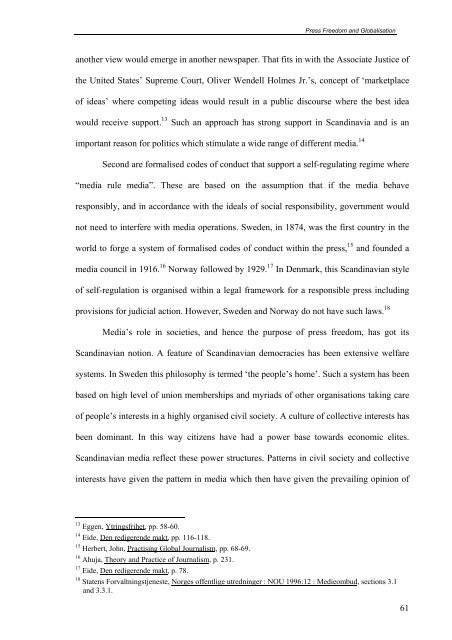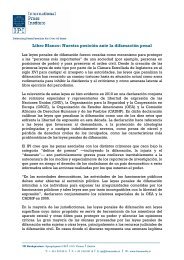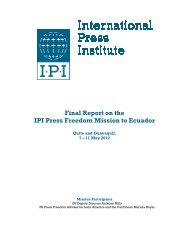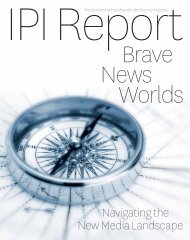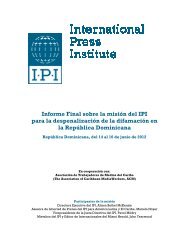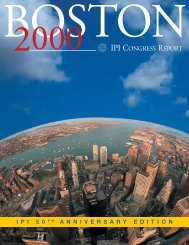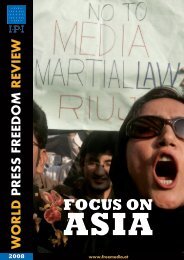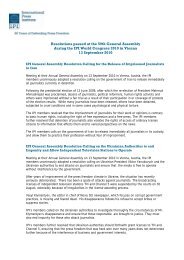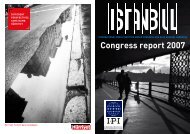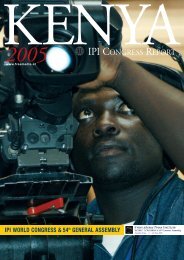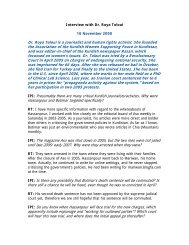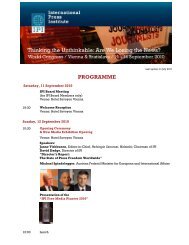Press Freedom and Globalisation - International Press Institute
Press Freedom and Globalisation - International Press Institute
Press Freedom and Globalisation - International Press Institute
Create successful ePaper yourself
Turn your PDF publications into a flip-book with our unique Google optimized e-Paper software.
<strong>Press</strong> <strong>Freedom</strong> <strong>and</strong> <strong>Globalisation</strong><br />
another view would emerge in another newspaper. That fits in with the Associate Justice of<br />
the United States’ Supreme Court, Oliver Wendell Holmes Jr.’s, concept of ‘marketplace<br />
of ideas’ where competing ideas would result in a public discourse where the best idea<br />
would receive support. 13 Such an approach has strong support in Sc<strong>and</strong>inavia <strong>and</strong> is an<br />
important reason for politics which stimulate a wide range of different media. 14<br />
Second are formalised codes of conduct that support a self-regulating regime where<br />
“media rule media”. These are based on the assumption that if the media behave<br />
responsibly, <strong>and</strong> in accordance with the ideals of social responsibility, government would<br />
not need to interfere with media operations. Sweden, in 1874, was the first country in the<br />
world to forge a system of formalised codes of conduct within the press, 15 <strong>and</strong> founded a<br />
media council in 1916. 16 Norway followed by 1929. 17 In Denmark, this Sc<strong>and</strong>inavian style<br />
of self-regulation is organised within a legal framework for a responsible press including<br />
provisions for judicial action. However, Sweden <strong>and</strong> Norway do not have such laws. 18<br />
Media’s role in societies, <strong>and</strong> hence the purpose of press freedom, has got its<br />
Sc<strong>and</strong>inavian notion. A feature of Sc<strong>and</strong>inavian democracies has been extensive welfare<br />
systems. In Sweden this philosophy is termed ‘the people’s home’. Such a system has been<br />
based on high level of union memberships <strong>and</strong> myriads of other organisations taking care<br />
of people’s interests in a highly organised civil society. A culture of collective interests has<br />
been dominant. In this way citizens have had a power base towards economic elites.<br />
Sc<strong>and</strong>inavian media reflect these power structures. Patterns in civil society <strong>and</strong> collective<br />
interests have given the pattern in media which then have given the prevailing opinion of<br />
13<br />
Eggen, Ytringsfrihet, pp. 58-60.<br />
14<br />
Eide, Den redigerende makt, pp. 116-118.<br />
15<br />
Herbert, John, Practising Global Journalism, pp. 68-69.<br />
16<br />
Ahuja, Theory <strong>and</strong> Practice of Journalism, p. 231.<br />
17<br />
Eide, Den redigerende makt, p. 78.<br />
18<br />
Statens Forvaltningstjeneste, Norges offentlige utredninger : NOU 1996:12 : Medieombud, sections 3.1<br />
<strong>and</strong> 3.3.1.<br />
61


